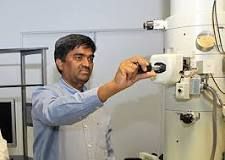Tuskegee researchers patent new technology to improve wastewater filtration methods
Published on by Water Network Research, Official research team of The Water Network in Academic
Rangari in lab.
Tuskegee University researchers in the College of Engineering and the College of Veterinary Medicine have been granted a patent by the U.S. Patent and Trademark Office for their innovative filtration system design for improved water filtration.
Dr. Vijay Rangari, a professor of materials science and engineering and his team — which includes Dr. Shaik Jeelani, Dr. Boniface Tiimob and Dr.Vitus Apalagya of the Department of Material Science and Engineering, and Dr. Samuel Temesgen in the Department of Pathobiology — are credited with the invention.
Through their research, these faculty found a need for a low-environmental impact water filtration system that removes naturally occurring levels of sodium, such as a filtration system to desalinate sea water. However, the hurdle for the research team to overcome was how best to enable a water filtration system that eliminates unacceptable levels of chemicals — including petroleum contaminates, bacteria and salts in a water source or supply.
Rangari explained water filtration and recovery technology is increasingly necessary as water resources are depleted and access to freshwater reservoirs is limited.
“Contamination of water sources is occurring from a variety of activities and industries, which include agricultural, automotive services and energy exploration,” he said.
Under the U.S. Patent No. 10583417, the water filtration and water recovery system will be able to collect and recycle water from various wastewater sources — including petroleum-containing water, as well as filter out other contaminants from water utilized in various industrial applications, including but not limited to car washes — so that the water can be collected and reused.
“Most of the water that is utilized in certain industrial applications must be collected and treated in order to remove contaminants that can include petroleum products, pesticides, herbicides, phosphates and detergents,” noted Rangari.
The water filtration system comprises a combination of two components — silver nanoparticles immobilized on a porous carbon solid matrix and calcium carbonate silver nanoparticles. The silver nanoparticles are prepared in a one-step wet ball milling process that does not use an environmentally hazardous reducing agent or an organic stabilizer. The calcium carbonate is preferably isolated from waste chicken egg shells.
Also provided is an in-situ method of preparing silver nanoparticles on active charcoal. Powdered-activated charcoal and silver nitrate are mixed together in a mixture of ethanol and water to form a charcoal-silver nitrate solution that is then subjected to ball milling in the presence of polypropylene glycol to produce silver nanoparticles on active charcoal.
Taxonomy
- Filtration Solutions
- Filtration
- Nanofiltration
- Water filtration, purifiers, nano filtration
